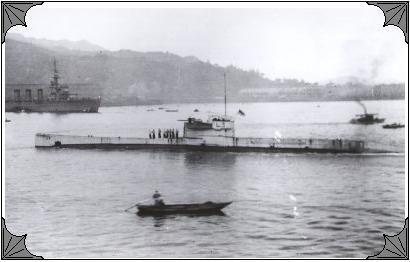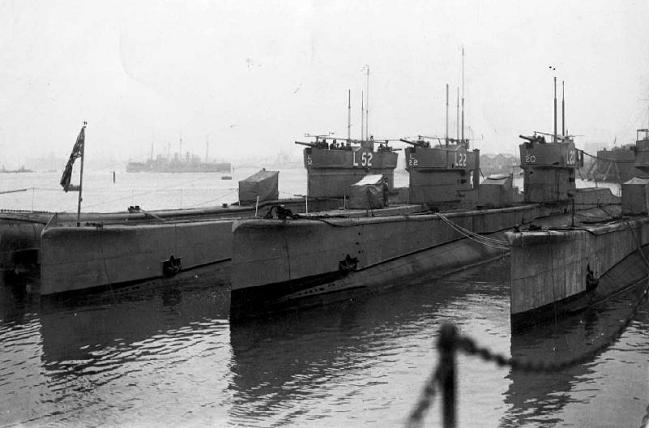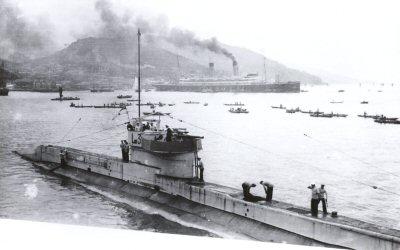
Imperial Japanese Navy - VICKERS L3 class Submarine ==========================================================================

The L type submarines were medium sized submarines of the Imperial Japanese Navy (IJN), serving during the 1920s and World War II. All L type submarines were designed by Vickers and built with their naval technical guidance. All boats were built in the Mitsubishi Heavy Industries-Kobe Shipyard under contract with Vickers.
The IJN L type submarines were divided into four class variant types; L1 - L4
L1 type (Ro-51 class)
In 1916, the Mitsubishi Shipbuilding Corporation obtained the Vickers L class submarine design information. Mitsubishi, which had lost a competition to the Kawasaki's F type submarines (Fiat-Laurenti type, Ro-1 class and Ro-3 class) , bought the license for the L class submarine from Vickers. The IJN hoped to improve their submarine technologies, and ordered this submarine from Mitsubishi. Mitsubishi bought 6 submarine kits from Vickers, and built 2 boats (submarine hulls # 25-26). IJN submarine crews were very satisfied with the Vickers diesels, because their reliability was high. The IJN studied this diesel engine and designed a lot of variants (example: Kampon Mk.24 diesel for Ro-100 class).
L2 type (Ro-53 class)
The remaining 4 kits were built as type L2 variants (submarine hulls # 27-30). The IJN L2 type had minor changes from the Vickers L1 type. Changed contents were removal of the ship's side torpedo tubes, and the installation of new batteries. (The L1 was equipped with 3 groups of 336 small-sized batteries. The L2 was equipped with 2 groups of 224 mediun-sized batteries.)
L3 type (Ro-57 class)
The IJN L3 type is a license production model of the Vickers L-class submarine Group 2.
L4 type (Ro-60 class)
The IJN L4 type is a license production model of the Vickers L-class submarine Group 3.
Their performance was such that the IJN was satisfied, and stopped development of the class.

BARROW SHIPYARD and VICKERS SUBMARINES
The Iron Shipbuilding Company was founded in 1871 by James Ramsden, General Manager of the Furness Railway Company who became first mayor of the new town of Barrow-in-Furness in Lancashire (now Cumbria). However, on registering the new company in 1872, the name was changed to the Barrow Ship Building Company (BSBC) when it was realised that there was already another company building iron ships further down the coast at Birkenhead.
1877 - First naval vessel ... 1886 - First submarines
In the first thirty years of its existence, Barrow shipyard built a wide range of surface ships of all types. They received their first naval vessel order from the British Admiralty in 1877 and cut their submarine-building teeth in 1886 on two steam-engined boats for the Swedish industrialist and arms dealer Thorsten Nordenfelt. These were ultimately sold to Turkey and Russia. The Turkish boat, Abdul Hamid, was dismantled for delivery by ship and re-erected at Taskizak Tersanesi shipyard, Istanbul. She achieved fame as the world's first submarine to fire a torpedo underwater. The submarine for Russia never reached her customer, foundering on the Jutland (Danish) coast on her delivery voyage.
The shipyard earned a growing reputation for quality-built naval ships and in 1888, having bought out the gun interests of the Maxim Nordenfelt Guns & Ammunition Company, was renamed the Naval Construction & Armaments Company.
1897 - Bought by Vickers
The company was bought by the Vickers family steel business of Sheffield for just £425,000 in 1897. In that same year, they also bought out Maxim Nordenfelt completely for £1,353,000. This acquisition enabled the company, now renamed Vickers, Sons & Maxim Limited, to proudly claim at the turn of the century that they were "the only shipbuilder capable of designing, building, engining and arming their own vessels."
1901 - The Royal Navy's First Submarine
The company was awarded the contract for the Royal Navy's first five submarines built to the latest design from the Irish-American John P Holland. The first submarine (officially Her Majesty's Submarine Torpedo Boat No.1 but not named at launch and usually referred to as Holland 1) was built with every secrecy at Barrow and launched 'as an experiment' without ceremony on October 2nd 1901. By the outbreak of war in 1914, Britain had the largest, most advanced and best supported submarine fleet in any world navy and Vickers had been responsible for 94% of the 74 submarines available.
Since that time, throughout the Second World War and thereafter, submarines continued to grow in status to become the capital ships in the Royal Navy's inventory… and Barrow shipyard has had an ongoing involvement in their design, build and development.
L Class Submarines.
The British L-class submarine were originally planned under the emergency war programme as an improved version of the British E-class submarine. Two years into WW I the admiralty realised its need for better submarines, to replace the E class which was now six years old. They reverted to the saddle tank design but with better machinery, which gave it better speeds. The first L-class hulls L1, and L2, were originally E57 and E58 which were initially going to be extended E class boats, but became the prototypes for the L class. The scale of change was such that allowed the L-class to become a separate class.
The L-class came too late to operate widespread in World War I but L12 torpedoed the German UB-90 and L10 torpedoed the German destroyer S 33. L55 was sunk just after World War I by Russian destroyers. She was then salvaged by the Russians and was commissioned by the Russians with her original number. L2 survived a fierce accidental attack by three American destroyers on 24 February 1918. The first heavy depth charge jammed the hydroplanes hard up. This cause a tremendous inclination to the stern with the tail of the submarine touching the sea bed at 300ft. Four more heavy depth charges exploded shaking the boat. The skipper, Lieut Cmdr Anworth, gave the order to blow the number 5 and 6 ballast tanks. L2 surfaced and came under fire by the 3 destroyers from about 1500 yards. One shot struck the pressure hull just abaft the conning tower. The crew waved white ensigns and fired rifles and the destroyers ceased fire. She survived the encounter.
The L-class submarines were built in three groups, each a modification of the basic model as their design evolved.
Several of the Group 1 boats were configured as minelayers including L11 and L12.
In the Group 2 boats, L14, L17 and L24 to L27 were built as minelayers carrying 16 mines but without the two beam torpedo tubes on the sides.
Their armament was increased when the 21-inch torpedoes came into service.
The Group 3 boats had two QF 4-inch guns fore and aft of the lengthened conning tower. Also, 76 tons of fuel oil was carried in external wing tanks for the first time on British submarines.
The L class served in the British Navy throughout the 1920s and the majority were scrapped in the 1930s but three remained operational as training boats during World War II. The last 3 were scrapped in 1946 after long distinguished service.

=================================================================================
NB: The above text has been collected / excerpted / edited / mangled / tangled / re-compiled / etc ... from the following online sources :
IJN - Vickers L3 class Submarine - www.submarineheritage.com
IJN - Vickers L3 class Submarine - www.battleships-cruisers.co.uk
IJN - Vickers L3 class Submarine - warshipsww2.eu
IJN - Vickers L3 class Submarine - wikipedia article #1
IJN - Japanese L-class Submarines - wikipedia article #2
IJN - British L class submarine - wikipedia article #3
IJN - Vickers L3 class Submarine - wikipedia article #4
IJN - Vickers L3 class Submarine - wikipedia article #5
IJN - Vickers L3 class Submarine - wikipedia article #6
IJN - Vickers L3 class Submarine - wikipedia article #7



